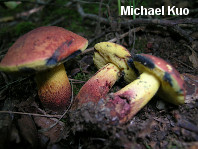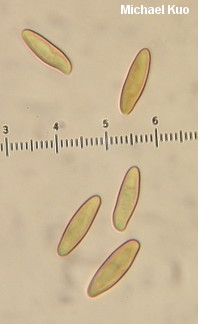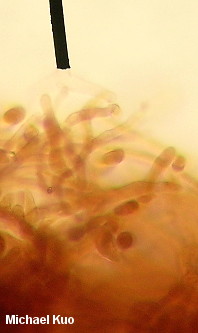| Major Groups > Boletes > Red-Capped, Blue-Staining > Boletus speciosus |

|
Boletus speciosus [ Basidiomycota > Boletales > Boletaceae > Boletus . . . ] by Michael Kuo This rare mushroom looks like a gorgeous, reticulate version of the more common and better known Boletus bicolor. The red and yellow colors are offset nicely by the indigo blue bruising. Microscopic features for Boletus speciosus include rather long and narrow spores, and a trichodermial pileipellis. I have only seen this species once, about 10 years ago, and on that day the photography gods were not my friends; I apologize for the terrible depth-of-field issues in the photo. Boletus pseudopeckii is similar but less brightly colored; its rusty red cap soon fades to tan (it also features a cutis rather than a trichoderm). Another look-alike, Boletus peckii, has a bitter taste and much shorter (9-12 µm) spores. Butyriboletus brunneus is similar but has a brown cap. Boletus speciosus was originally described from New York (Frost, 1874), and is apparently fairly widespread in eastern North America's hardwood forests. The Europeans have applied the name to a very similar species found in Switzerland and northern Italy; whether or not it is actually the same as the North American species is not clear. As described by Breitenbach & Kränzlin (1991), it has much wider spores and more brown in the cap than the species described and illustrated here. My specimens, described below, were significantly smaller than the robust mushrooms featured in most descriptions; generally the cap dimensions are reported as 8-15 cm across, with stem dimensions as 5-13 x 1.5-4 cm (Smith, Smith & Weber, 1981). Description: Ecology: Mycorrhizal with oaks and other hardwoods; growing alone or scattered; summer and fall; rare; apparently widely distributed in eastern North America. The illustrated and described collection is from Illinois. Cap: 3-4.5 cm across (see note below); convex, becoming broadly convex; dry; bald or very finely felty; bright red, fading only slightly, to brick red; bruising blue. Pore Surface: Bright yellow, becoming olive yellow; bruising promptly blue; 2 pores per mm at maturity; tubes to about 1 cm deep. Stem: 3-4 cm long; 1-2 cm thick (see note below); equal or with a swollen base; dry; solid; yellow above, red below; reticulate over the top half or overall; bruising promptly blue; basal mycelium dark red. Flesh: Yellowish to yellow in the cap; red in the stem; staining quickly blue when sliced. Odor and Taste: Not distinctive. Chemical Reactions: Ammonia negative to yellowish on cap; erasing blued areas on flesh. KOH grayish to blackish on cap surface; pale orange on flesh. Iron salts greenish olive on cap; negative on flesh. Spore Print: Olive brown. Microscopic Features: Spores 13-17 x 3.5-5 µ; smooth; long-fusiform; golden in KOH. Basidia 4-spored. Hymenial cystidia occasional; narrowly fusoid-ventricose. Pileipellis a tangled, collapsing trichoderm of brown to golden, smooth elements REFERENCES: Frost, 1874. (Saccardo, 1891; Coker & Beers, 1943; Snell & Dick, 1970; Smith & Thiers, 1971; Smith, Smith & Weber, 1981; Breitenbach & Kränzlin, 1991; Phillips, 1991/2005; Both, 1993; Bessette, Roody & Bessette, 2000.) Herb. Kuo 07170403. This site contains no information about the edibility or toxicity of mushrooms. |
© MushroomExpert.Com |
|
Cite this page as: Kuo, M. (2014, December). Boletus speciosus. Retrieved from the MushroomExpert.Com Web site: http://www.mushroomexpert.com/boletus_speciosus.html |


